1HD-FTE vs 2.8L Cummins Engine: Diesel Engine Showdown
🔧 1HD-FTE vs 2.8L Cummins Engine: A Diesel Engine Comparison
Which Diesel Beast is Best for Your 4×4, Truck, or Swap Project?
Whether building your dream overland rig, swapping a new old tired engine for a new replacement one, or installing a performance and reliability upgrade, choosing the proper diesel engine is one of the most important decisions you will ever make. And two of the most debated engines available today are the Toyota 1HD-FTE and the Cummins 2.8L R2.8 Turbo Diesel.
Both of these engines are industry leaders in themselves, known for being rugged, fuel-sipping, and off-road capable. So which one do you pick? And more importantly — where the bleep do you even find one?
In this definitive guide, here, we’ll be discussing:
- The technical specifications on both engines
- Real-world performance comparison
- Reliability and ease of installation
- Availability and cost
- Why we stock both engines — and which one might be your ultimate companion
⚙️ Overview: Toyota 1HD-FTE vs Cummins 2.8L
| Feature | Toyota 1HD-FTE | Cummins 2.8L R2.8 |
|---|---|---|
| Engine Type | Inline-6 Turbo Diesel | Inline-4 Turbo Diesel |
| Displacement | 4.2L | 2.8L |
| Horsepower | ~204 HP | ~161 HP |
| Torque | ~430 lb-ft | ~310 lb-ft |
| Fuel System | Common Rail Direct Injection | Bosch Common Rail |
| Emissions | Euro IV / V Compliant | EPA Certified |
| Weight | ~280kg | ~230kg |
| ECU | Toyota Standalone or Integrated | Standalone with harness included |
| Best Use | Heavy-duty 4x4s, towing, overland builds | Light trucks, daily drivers, modern swaps |
🦾 Toyota 1HD-FTE: A Legend in Heavy-Duty Diesel
The 1HD-FTE is a unicorn. One of Toyota’s most advanced inline-6 diesel engines, the 1HD-FTE supplants the highly-acclaimed 1HD-FT but includes common-rail fueling and extra torque in the bargain.
🔧 Specifications:
- Displacement: 4.2L (4164cc)
- Configuration: Inline-6 Turbo Diesel
- Horsepower: ~204 HP @ 3,400 RPM
- Torque: ~430 lb-ft @ 1,800 RPM
- Fuel System: Common Rail Direct Injection
- Turbocharger: Variable Geometry Turbo (VGT)
- Weight: Approx. 280kg
- Cooling: Water-cooled
- Compression Ratio: 18.6:1
- ECU: Toyota OEM or aftermarket control
🚙 Applications:
- Toyota Land Cruiser 100 Series (HDJ100)
- Used for serious heavy off-road work, tow trucks, and expedition rigs
✅ Pros:
- Terror-izingly strong construction — built for long-term power
- Tremendously high torque at low RPM
- Quiet-smooth like a diesel
- Legendary Toyota toughness
- Excellent for serious heavy construction or heavy 4WD use
❌ Cons:
- Large and heavy over 4-cylinder versions
- Not necessarily emission compliant in strict jurisdictions
- Less available in some areas
🔩 Cummins 2.8L R2.8: The Modern Swap King
The Cummins R2.8 is an engine-swapping engineered crate engine featuring a full standalone ECU, wiring harness, and installation manual — no guessing required.
🔧 Specifications:
- Displacement: 2.8L (2799cc)
- Configuration: Inline-4 Turbo Diesel
- Horsepower: ~161 HP @ 3,600 RPM
- Torque: ~310 lb-ft @ 1,800 RPM
- Fuel System: Bosch Common Rail
- Turbocharger: Wastegate Turbo
- Weight: Approx. 230kg
- Emissions: US EPA Certified
- ECU: Standalone with plug-and-play harness
- Oil Capacity: 10.5 quarts
🚗 Applications:
- Jeep Wrangler, Land Rover Defender, Toyota Hilux, classic trucks, classic SUVs
- Legal for driving in all 50 US states (proper emissions configuration)
✅ Pros:
- Turn-key engine replacement solution
- Lightweight and compact
- Emissions friendly and low maintenance
- Great fuel efficiency (~25+ MPG)
- Engineered with state-of-the-art Bosch systems
- Backed by Cummins parts and service network
❌ Cons:
- Less power and torque than the 1HD-FTE
- Not designed for towing large loads
- Inline-4 design not as smooth as an inline-6
🛠️ Installation & Compatibility
🛞 Toyota 1HD-FTE:
- Some special fab work may be necessary depending on vehicle
- Seats well on Land Cruiser chassis
- Powerful aftermarkets, but not plug-and-play
- Requires proper calibration and compatible transmission installation
⚙️ Cummins 2.8L:
- Package full installation kit
- Compatible with variety of well-known transmissions (NV4500, 4L80E, AX15, etc.)
- Extensive instruction manuals and support from Cummins Repower program
- Very low wiring and ECU guesswork
💵 Cost & Availability
💰 Toyota 1HD-FTE:
- Used/Rebuilt Price: $8,500–$12,000 (dependent upon condition)
- Low availability, especially outside Australia, Middle East, and Japan
- Core availability limited by overseas demand
- We offer warrantied quality-tested rebuilt 1HD-FTEs from our store
💰 Cummins 2.8L:
- Crate engine price: ~$9,000–$10,500
- Available to ship right away in North America and Europe
- Warranty and emissions certification included with every purchase straight out of the box
- New 2.8L Cummins crate engines for sale and shipping
⚖️ Side-by-Side Use Cases
🏔️ Overland Build
Winner: 1HD-FTE — greater torque, improved weight and load capacity
🚘 Daily Driver / Fuel Efficiency
Winner: Cummins 2.8L — lighter, better mileage, easier install
🚛 Towing / Heavy-Duty Application
Winner: 1HD-FTE — better load stress, better long-term life
🔧 Engine Swap Convenience
Winner: Cummins 2.8L — plug-and-play from the box, dedicated ECU, less surprise
🌍 World Travel / Remote Repair
Winner: 1HD-FTE — Toyota diesel mechanics and spares are everywhere
🏪 Why Buy From Us?
We specialize in the top diesel engines like remanufactured 1HD-FTE engines and new Cummins 2.8L crate engines. We have warranted inventory that we inspect and ship globally.
🛠️ What You Get:
- Inspection-represented engines with reports
- Actual support from diesel experts
- Rapid, secure global shipping
- Custom builds and swap consulting available
- OEM parts and accessories access
No matter if you’re selling to a 70 Series, a Jeep TJ, or an old FJ60, we’ve got the proper engine for you — and we’ll help you choose the best one.
📌 Last Word: What Engine Do You Buy?
It depends on what you’re doing.
✅ Choose the Toyota 1HD-FTE when:
- You want maximum torque and reliability
- You’re building an overland truck or expedition vehicle
- You’re selling to a Land Cruiser or a heavy-duty 4WD
- You need Toyota dependability and international parts support
✅ Choose the Cummins 2.8L R2.8 if:
- You need plug-and-play diesel conversion
- You’re in the US and need EPA emissions compliance
- You need economy and new wiring
- You’re building a daily driver or light 4×4
No matter which engine you choose, you’re getting a class-leading diesel monster.
🛒 Interested in Buying?
➤ We provide tested and rebuilt Toyota 1HD-FTE engines.
➤ We stock brand-new Cummins 2.8L R2.8 crate engines — ready for your next swap.
📞 Call now or inquire for a quote to begin.
🤝 Not So Sure About This?
Speak with one of our diesel engine specialists. We’ll walk you through your build, your dreams, and your budget — and choose the perfect engine for you.
✅ Quality Engines
✅ International Shipping
✅ Expert Advice
🔥 Your Diesel Dream Begins Here
Diesel swaps aren’t just about power — they’re about freedom, reliability, and building something that lasts. Whether it’s the raw power of the 1HD-FTE or the modern efficiency of the Cummins 2.8, we’ve got the engine for you.
🚀 Ready to upgrade? Let’s talk.
Installation Guide for the Yanmar 8LV370 Inboard Diesel Engine
Customer Reviews and Experiences with the Yanmar 8LV370 Inboard Diesel Engine
Best Applications for the Yanmar 8LV370 Inboard Diesel Engine
Ultimate Guide to Upgrading the Chevy LS3 6.2L V8 to 700+ HP
Unveiling the Power and Precision of Subaru Engines: A Comprehensive Guide








